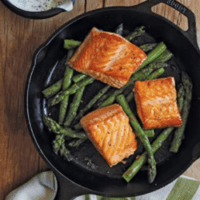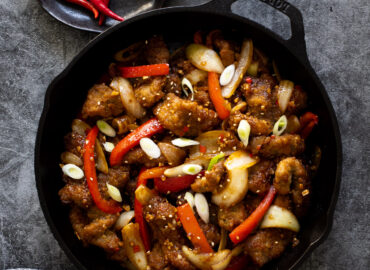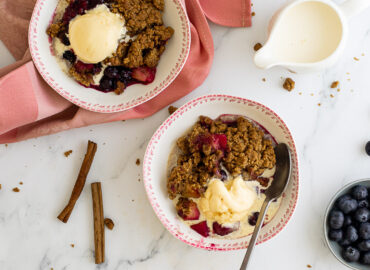*This post may contain affiliate links. Read my disclaimer here. While we may use affiliate links, we would never allow this to influence product listings or recommendations.
Bavette steak is an uncommon cut to find in your local supermarket and is often referred to as a butcher’s cut. A cut of meat which butchers keep to themselves because they are tricker to prepare and cook than other parts of beef yet is utterly delicious when done right. Because of this, it’s not something many people try their hand at cooking at home. If you want to try this flavoursome and rich steak then read on to find out more about what it is, how to prepare it and different ways you can use it.
In general, there are 3 major selling points for this cut:
- It’s much cheaper than some other popular cuts of steak (in the UK it’s up to half the price of ribeye)
- It is extremely flavoursome
- It’s well suited to fast cooking
Is Bavette the same as flank steak?
Many sources you find will tell you that bavette is simply the French word for flank steak. However, they are actually slightly different cuts although they are from the same part of the cow and have many similarities. I asked my butcher about the variances, and he explained that bavette is a little bigger and that the fibres in the meat are both longitudinal and transversal. A little technical I know, so I had to try and work out exactly what this meant in terms of taste and texture.

In the spirit of testing, I bought both cuts to see if I could discern a difference in taste or texture once cooked. The fibres in bavette steak are looser and seem almost deeper, making the cut less dense. Bavette is also a more tender piece of meat (compared to a flank prepared and cooked in the exact same way).
What is it?
The name Bavette comes from the French ‘bib’ so you’ll usually find it goes by this name in France or French restaurants or butchers.
It comes from the abdomen muscles of the cow and so is a very lean cut with practically no fat which means it can be a little tough unless prepared properly. It has a very strong flavour and as it is quite lean it lends itself well to quick cooking. It’s a perfect option for any dish where you need fast-cooked beef such as a stir-fry or tacos.
You can also serve full bavette steak after pan-frying or grilling as you would any standard steak.

What does it taste like?
Bavette steak has a strong flavour and the taste is innately beefy. For anyone who’s used to eating fillet or even ribeye steaks, it will be quite the contrast. However, many chefs regard this cut as completely underrated and many people tasting bavette steak for the first time will wonder why this cut is not more popular!
As bavette can be quite tough if cooked incorrectly it’s important to make sure to prepare it in the appropriate method (see more below). You also need to make sure to cut the meat across the grain not in the direction of the grain. This results in having shorter fibres in the meat which makes it much more tender.
What can I serve it with?
You can serve a bavette steak in the same way you would a classic ribeye or fillet. A few select side dishes and a flavoursome sauce are always welcome accompaniments.
Side dish ideas
- Lemon and thyme roast potatoes
- Roasted leeks and tomatoes
- Balsamic grilled asparagus with red onion
- Kale coleslaw
- Parsnip and potato mash
Sauce ideas
- Italian salsa verde – adds a fresh and herby note to the dish
- Diane sauce – the classic, creamy mushroom steak sauce
- Red wine jus – for an added decadence and richness
- Red pesto – which might seem a little unconventional, but this earthy sauce is delicious with just about anything!

How to prepare it before cooking
If you buy steak that has not been fully prepared by the butcher, then you may need to slice it into portions. Make sure that each piece isn’t too large (as Bavette is typically uneven in thickness it will cook less evenly the more variation you have). If there is a silvery film over parts of the meat, then you can also use a sharp knife to carefully cut underneath it and peel this off.
If you are cooking bavette to eat as a whole steak (centre of the plate) then advance prep is key to getting a tender result. It’s best served after marinading for several hours (a minimum of 3, but ideally overnight) to increase the tenderness of the steak. This will help to break the meat down whilst also adding flavour. See below for some great marinade options. Alternatively, you can tenderise the meat by hammering it (see more below in ‘how to cook’).
If you are cooking the steak to use in a stir-fry or something like fajitas, then you can slice it into thin pieces first. Make sure to slice across the grain not along the length of the grain to get a tender result. Again, marinading is recommended.
However you choose to cook the steak, make sure to remove it from the fridge a good hour before cooking to allow it to reach room temperature.
How to cook it
As it has no significant fat content Bavette steak should be cooked quickly or else it will toughen up.
For stir fry
If you are cooking the steak sliced into smaller pieces, then make sure that the pan is extremely hot so you can flash fry it in the shortest time possible.
Don’t cook small slices of beef for more than 1-2 minutes. This may mean that you need to adjust the recipe steps slightly. You can always cook the beef in batches and set it aside while you prepare the rest of the dish and then add the beef back in at the end before serving.
As a whole steak

- When you come to cook the steak pat it dry all over with a paper towel. You don’t want any liquid left sitting on the surface of the steak as this will make it boil in the pan rather than sear – so you won’t get that beautiful dark crust on the surface which adds a ton of flavour.
- You’re going to want to use a high smoke point oil as you need to sear the steak at a very high temperature – so it will get smoky! First, add oil to one side of the steak and season well.
- Next, add a couple of teaspoons of oil to the pan and make sure that it is searing hot. The best type of pan to use is cast iron, while the worst is a non-stick pan that won’t get as deep a sear.
- Once the oil is smoking hot add the steak, seasoned side down. Use the back of a spatula or tongs to press it down so the meat is fully in contact with the pan. Then leave it alone and don’t be tempted to try and turn the steak over until it’s ready.
How long should I cook it?
When you are nearly ready to flip the steak season the exposed side before turning. For a medium-rare steak, you should cook for around 2.5 minutes on each side. Using a temperature probe is a good idea to get the perfect result as the thickness of the steak and the heat of the pan will affect the time required.
| Doneness | Estimated cooking time | Remove from the pan at… | Temperature once rested… |
| Rare | 1.5 – 2 minutes per side | 55ºC | 130ºF | 60ºC | 140ºF |
| Medium-Rare | 2.5 minutes per side | 60ºC | 140ºF | 63ºC | 145ºF |
| Medium | 3 minutes per side | 68ºC | 155ºF | 70ºC | 160ºF |
(I don’t recommend cooking a bavette steak above medium, and for best results go for rare or medium-rare).
Once the steak is cooked make sure to rest it – and don’t be tempted to skip this step! Place it on a board or plate covered with some foil for ideally 10 minutes, but at least 5.
When cutting the steak make sure to cut it against the grain. If you are serving to guests it may be worth cutting the steak before serving to make sure that it’s not cut in the wrong way at the table!
Ingredients
For a full list of ingredients with measurements jump to the printable recipe card.
- Bavette steak (see above for preparation tips if not fully prepared by your butcher)
- Canola oil – or any oil with a high smoke point
Marinades
Option 1 – Red wine & Rosemary

- Red wine – ideally use one with high acidity such as pinot noir or grenache
- Garlic – crushed or finely chopped
- Rosemary – leaves stripped from stems
- Salt and pepper
Option 2 – Honey & Bourbon
- Olive oil
- Honey
- Bourbon – spring for a good quality bottle
- Red wine vinegar
- Salt and pepper
Option 3 – Soy Sauce & Garlic
- Lemon juice
- Soy sauce
- Worcestershire sauce
- Garlic – crushed or finely chopped
Looking for more great meaty recipes? Try:
- Slow cooker gammon
- Easy beef stroganoff
- Lamb steak with feta and mint gnocchi
- Minted lamb chops
- Minted lamb shanks
Products that work well for this recipe:

OXO Good Grips Meat Tenderiser

Lodge Cast Iron Pan

Beeswax Food Wraps

Bavette Steak
- Total Time: 25 minutes
- Yield: 2 1x
Description
With an extremely distinctive flavour and a handful of different uses, bavette steak can be a really tender and delicious cut when cooked the right way.
Notes:
Each marinade option makes enough for roughly two steaks.
If you are planning on thinly slicing and stir-frying the steak then see tips in the main recipe post.
The prep time indicated does not include time to marinade (at least 3 hours)
Ingredients
- 2 bavette steaks, around 175g each
- 1 tbsp canola oil (see note 1)
Marinades (each will make enough for around 2 steaks)
Option 1 – Red wine & Rosemary
- 125ml / 1/2 cup red wine (see note 2)
- 2 cloves garlic – crushed or finely chopped
- 1 tbsp Rosemary leaves (stripped from stems) (see note 3)
- Salt and pepper – a pinch or two of each
Option 2 – Honey & Bourbon
- 2 tbsp olive oil
- 1 tbsp honey
- 60ml / 1/4 cup bourbon
- 2 tbsp red wine vinegar
- Salt and pepper – a pinch or two of each
Option 3 – Soy Sauce & Garlic
- 2 tbsp lemon juice
- 60ml / 1/3 cup light soy sauce
- 2 tbsp Worcestershire sauce
- 1 clove garlic – crushed or finely chopped
- Salt and pepper – a pinch or two of each
Instructions
- First make the marinade by mixing together all of the ingredients in a wide bowl from your chosen option above. Place the steak in the marinade and turn to cover with the liquid and then cover with cling film and place in the fridge for at least 3 hours, but ideally overnight.
- One hour before you are going to cook the steaks remove from the fridge to allow to come to room temperature.
- Transfer the steaks to a few sheets of paper towel and blot down thoroughly so there is no liquid left on the surface. Rub a little oil on one side and season well with salt and pepper.
- Heat the oil in a frying pan / skillet (see note 4). Place over high heat until the oil is smoking hot (see note 5).
- Place the steak seasoned side down into the oil, laying it away from you as you gently put it in. Leave for around 2.5 minutes (for a medium-rare steak) before seasoning the exposed side well and flipping and cooking for a further 2.5 minutes. (see note 6)
- Place the steak on a cutting board or plate and cover with foil. Leave for 10 minutes to rest before serving.
- Make sure to slice the cooked steak against the grains running through the steak rather than in the same direction – this will make sure each piece is tender and succulent.
Notes
- You can use any oil with a high smoke point
- Although any wine will work, use one with a higher acidity such as pinot noir or grenache.
- You can use dried rosemary instead of fresh, use around 1 tsp of dried for every 1 tbsp of fresh
- For best results use a cast iron pan. The worst kind to use is non-stick, which won’t give as deep a sear.
- When you properly sear a steak (or other meat) there will be smoke! An extractor fan or open door is highly recommended.
- For the best results use a kitchen thermometer to check the internal temperature of the steak. For a rare steak remove from the pan at 55C/130F or 60C/140Ffor medium-rare (rare or medium-rare is the best doneness level for this type of steak).
- You can serve the steaks with your choice of sauce. I can strongly recommend this Diane sauce or this red wine jus.
- Prep Time: 10 minutes
- Cook Time: 15 minutes
- Category: Dinner
- Method: Fry
- Cuisine: French
Nutrition
- Serving Size: 1
- Calories: 360
- Fat: 25g
- Carbohydrates: 0g
- Protein: 33g
Keywords: steak, bavette, French, dinner, indulgent, meat, beef





